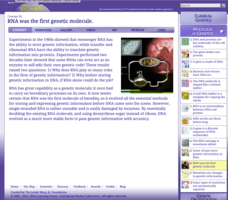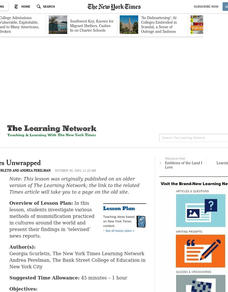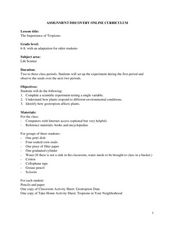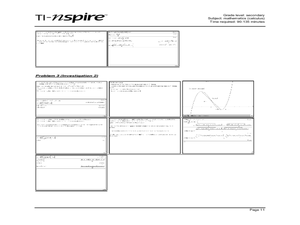Curated OER
Scientific Inquiry
Sixth graders research the theories on the extinction of the dinosaurs. In this dinosaur extinction activity, 6th graders view a video clip about scientific inquiry. They work in groups to research the two theories on dinosaur extinction.
Curated OER
Diffusion of Molecules
Students conduct a series of experiments to observe factors that impact molecular movement. For this molecular chemistry lesson, students drop food coloring in water with different properties (hot, with ice, with alcohol) and observe how...
Curated OER
States Of Matter
Delv into the states of Matter. Students engage in the scientific inquiry process to uncover the exciting world of Matter. They watch a series of videos, and conduct experiments in order to collect and analyze data on the various state...
Teach Engineering
Inside the DNA
Get your class to take a closer look at DNA. Pupils conduct research to determine the methods used by scientists to analyze the molecular structure of DNA. The class members investigate different types of molecular imaging along with gel...
Cold Spring Harbor Laboratory
RNA Was the First Genetic Molecule
Can organic molecules come from a pre-biotic environment? Stanley Lloyd Miller proved it is possible when exactly the right conditions exist. Learn about his experiment and the other experiments later building off of it that changed the...
Curated OER
DNA, the Awesome Thread of Life
Students examine how traits are passed to offspring. For this genetic reproduction lesson students develop a model of dna and learn about its structure, replication and function.
American Chemical Society
Energy and Entropy of a Stretched Rubber Band
Stephen Perry invented and patented the modern rubber band in 1845. Young scientists put his discovery to work as they use rubber bands to observe entropy and enthalpy. They determine the change in free energy to figure out if it...
West Contra Costa Unified School District
Introduction to Inverse Functions
Ready to share the beauty of the inverse function with your classes? This algebra II lesson guides the discovery of an inverse function through a numerical, graphical, and an algebraic approach. Connections are made between the three,...
Curated OER
Evolution of Observation
Students develop an awareness of the evolution of the scientific method. They facilitate the student's knowledge of looking at variables from different perspectives. Students develop their abilities to defend their ideas with facts or...
Curated OER
Adding Fractions with Unlike Denominators
Students explore why denominators need to match before adding (or subtracting) a fraction. They use unmarked fraction circles and marked fraction bars, to discover a method to add fractions with unlike denominators using equivalent...
Curated OER
GED Math: Internet Support for Varied Solution Methods
Twelfth graders, who teach GED classes, discuss math as an individual problem solving process rather than as a single method of getting the right answer. They visit Websites dealing with math problem solving situations and answer...
Curated OER
Mummies Unwrapped
Learners investigate various methods of mummification practiced in cultures around the world and present their findings in 'televised' news reports.
Curated OER
CAN'T TOUCH THIS!
Students discover the best practical shielding material when dealing with radioactive substances. They draw conclusions based on availability of materials, price, and best shielding properties.
Curated OER
Migrant Workers Through the Lens of Dorothea Lange
Students explore the lives of migrant workers during the Great Depression. In this Great Depression lesson, students examine photographs and song lyrics to gain an understanding of the conditions for people living in the era. Students...
Curated OER
Pond Ecology
A lab activity is a great way to incite thoughtful questioning and scientific processes. Pupils will collect organisms with a Petri dish, make observations, sketch the organism, ask questions, then attempt to identify the specimen...
Curated OER
Lewis and Clark: Prized Possessions
Young scholars consider the role of Sacagawea as part of the Corps of Discovery. In this Lewis and Clark expedition lesson, students discover details about Sacagawea's wampum belt and then create their own wampum belts using their...
Curated OER
Erosion Lab
Eighth graders explore variables that influence the rate of erosion due to the 4 major agents. They work as a group and practice conducting experiments according to the scientific method. Students comprehend that communicating ideas...
Curated OER
Living and Nonliving
Students use their senses to record and collect data. In How Do I Classify Things in My World?, students practice classifying objects as living or nonliving. In Is it Real Or Pretend?, students group objects as real or pretend. In What...
Curated OER
Atomic Structure and Bonding
Eighth graders discuss and write about what led up to the discovery of the atom. Students label proton, nucleus, electron, and neutron in their notes. Students take notes on electron shells and how different atoms have different...
Curated OER
Plant Pollination
Students investigate methods of pollination for various flowers. In this plant biology lesson, students learn the parts of a flower and form a hypothesis about the method of pollination for the flower. They determine the validity of...
Curated OER
The Importance of Tropisms
Middle schoolers investigate plant tropisms using the scientific method. In this life science lesson, students learn about tropisms and test the response of corn seedlings to gravity. Response questions, extensions, and an...
Curated OER
Two Investigations of Cubic Functions
Through learning about cubic functions, high schoolers graph cubic functions on their calculator. Students determine the local maximum and minimum points and the tangent line from the x-intercept to a point on the cubic...
Curated OER
Brown Bag Science
Students discover, through the discovery method, how electricity works. They construct a simple circuit and a parallel circuit, make an electrical motor work and add a switch to turn it on and off.
Curated OER
"Adding It Up" at James Fort
Students discuss jettons and their archaeological importance at Jamestown. They then practice using historic counting sheets and artifacts to understand the calculating methods of the early 17th Century, and identify their similarities...























